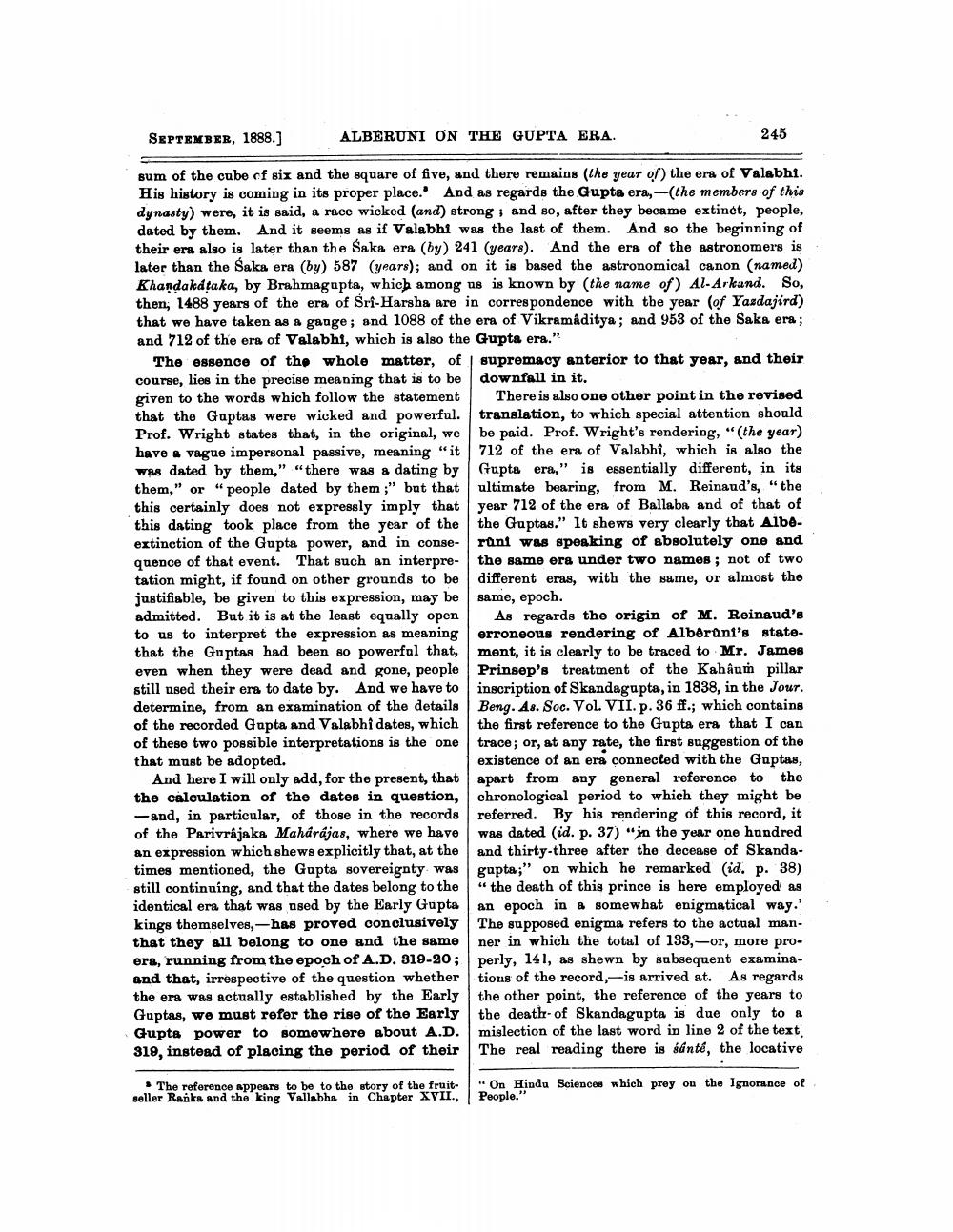________________
SEPTEMBER, 1888.]
ALBERUNI ON THE GUPTA ERA.
sum of the cube of six and the square of five, and there remains (the year of) the era of Valabhi. His history is coming in its proper place. And as regards the Gupta era,-(the members of this dynasty) were, it is said, a race wicked (and) strong; and so, after they became extinct, people, dated by them. And it seems as if Valabhi was the last of them. And so the beginning of their era also is later than the Saka era (by) 241 (years). And the era of the astronomers is later than the Śaka era (by) 587 (years); and on it is based the astronomical canon (named) Khandakdṭaka, by Brahmagupta, which among us is known by (the name of) Al-Arkand. So, then, 1488 years of the era of Sri-Harsha are in correspondence with the year (of Yazdajird) that we have taken as a gauge; and 1088 of the era of Vikramaditya; and 953 of the Saka era; and 712 of the era of Valabhi, which is also the Gupta era."
The essence of the whole matter, of course, lies in the precise meaning that is to be given to the words which follow the statement that the Guptas were wicked and powerful. Prof. Wright states that, in the original, we have a vague impersonal passive, meaning "it was dated by them," "there was a dating by them," or "people dated by them;" but that this certainly does not expressly imply that this dating took place from the year of the extinction of the Gupta power, and in consequence of that event. That such an interpretation might, if found on other grounds to be justifiable, be given to this expression, may be admitted. But it is at the least equally open to us to interpret the expression as meaning that the Guptas had been so powerful that, even when they were dead and gone, people still used their era to date by. And we have to determine, from an examination of the details of the recorded Gupta and Valabhî dates, which of these two possible interpretations is the one that must be adopted.
And here I will only add, for the present, that the calculation of the dates in question, -and, in particular, of those in the records of the Parivrâjaka Mahárájas, where we have an expression which shews explicitly that, at the times mentioned, the Gupta sovereignty was still continuing, and that the dates belong to the identical era that was used by the Early Gupta kings themselves, has proved conclusively that they all belong to one and the same era, running from the epoch of A.D. 319-20; and that, irrespective of the question whether the era was actually established by the Early Guptas, we must refer the rise of the Early Gupta power to somewhere about A.D. 319, instead of placing the period of their
245
The reference appears to be to the story of the fruitseller Ranka and the king Vallabha in Chapter XVII.,
supremacy anterior to that year, and their downfall in it.
There is also one other point in the revised translation, to which special attention should. be paid. Prof. Wright's rendering, "(the year) 712 of the era of Valabhi, which is also the Gupta era," is essentially different, in its ultimate bearing, from M. Reinaud's, "the year 712 of the era of Ballaba and of that of the Guptas." It shews very clearly that Albêruni was speaking of absolutely one and the same era under two names; not of two different eras, with the same, or almost the same, epoch.
As regards the origin of M. Reinaud's erroneous rendering of Alberûni's statement, it is clearly to be traced to Mr. James Prinsep's treatment of the Kahâum pillar inscription of Skandagupta, in 1838, in the Jour. Beng. As. Soc. Vol. VII. p. 36 ff.; which contains the first reference to the Gupta era that I can trace; or, at any rate, the first suggestion of the existence of an era connected with the Guptas, apart from any general reference to the chronological period to which they might be referred. By his rendering of this record, it was dated (id. p. 37) "in the year one hundred and thirty-three after the decease of Skandagupta;" on which he remarked (id. p. 38) "the death of this prince is here employed as an epoch in a somewhat enigmatical way.' The supposed enigma refers to the actual manner in which the total of 133,-or, more properly, 141, as shewn by subsequent examinations of the record,-is arrived at. As regards the other point, the reference of the years to the death of Skandagupta is due only to a mislection of the last word in line 2 of the text The real reading there is santé, the locative
"On Hindu Sciences which prey on the Ignorance of People."




